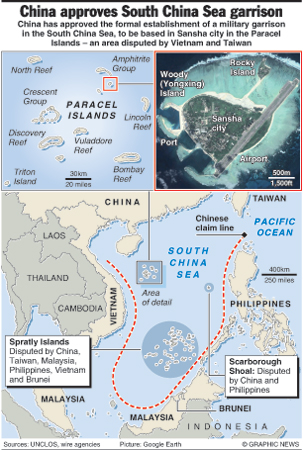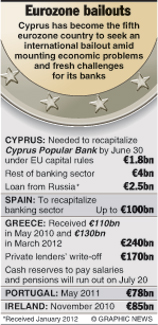Sunday Times 2
Calming the South China Sea
View(s):CANBERRA – The South China Sea – long regarded, together with the Taiwan Strait and the Korean Peninsula, as one of East Asia’s three major flashpoints – is making waves again. China’s announcement of a troop deployment to the Paracel Islands follows a month in which competing territorial claimants heightened their rhetoric, China’s naval presence in disputed areas became more visible, and the Chinese divided the Association of South East Asian Nations (ASEAN), whose foreign ministers could not agree on a communiqué for the first time in 45 years.
All of this has jangled nerves — as did similar military posturing and diplomatic arm wrestling from 2009 to mid-2011. Little wonder: stretching from Singapore to Taiwan, the South China Sea is the world’s second-busiest sea-lane, with one-third of global shipping transiting through it.

More neighbouring states have more claims to more parts of the South China Sea — and tend to push those claims with more strident nationalism — than is the case with any comparable body of water. And now it is seen as a major testing ground for Sino-American rivalry, with China stretching its new wings, and the United States trying to clip them enough to maintain its own regional and global primacy.
The legal and political issues associated with the competing territorial claims — and the marine and energy resources and navigation rights that go with them — are mind-bogglingly complex. Future historians may well be tempted to say of the South China Sea question what Lord Palmerston famously did of Schleswig-Holstein in the 19th century: “Only three people have ever understood it. One is dead, one went mad, and the third is me — and I’ve forgotten.”
The core territorial issue currently revolves around China’s stated interest — imprecisely demarcated on its 2009 “nine-dashed line” map — in almost the entire Sea. Such a claim would cover four disputed sets of land features: the Paracel Islands in the northwest, claimed by Vietnam as well; the Macclesfield Bank and Scarborough Reef in the north, also claimed by the Philippines; and the Spratly Islands in the south (variously claimed by Vietnam, the Philippines, Malaysia, and Brunei, in some cases against each other as well as against China.)
There has been a scramble by the various claimants to occupy as many of these islands — some not much more than rocks — as possible. This is partly because, under the United Nations Convention on the Law of the Sea, which all of these countries have ratified, these outcroppings’ sovereign owners can claim a full 200-mile Exclusive Economic Zone (enabling sole exploitation of fisheries and oil resources) if they can sustain an economic life of their own. Otherwise, sovereign owners can claim only 12 nautical miles of territorial waters.
What has heightened ASEAN’s concern about Beijing’s intentions is that even if China could reasonably claim sovereignty over all of the land features in the South China Sea, and all of them were habitable, the Exclusive Economic Zones that went with them would not include anything like all of the waters within the dashed-line of its 2009 map. This has provoked fears, not unfounded, that China is not prepared to act within the constraints set by the Law of the Sea Convention, and is determined to make some broader history-based claim.
A sensible way forward would begin with everyone staying calm about China’s external provocations and internal nationalist drumbeating. There does not appear to be any alarmingly maximalist, monolithic position, embraced by the entire government and Communist Party, on which China is determined to steam ahead. Rather, according to an excellent report released in April by the International Crisis Group, its activities in the South China Sea over the last three years seem to have emerged from uncoordinated initiatives by various domestic actors, including local governments, law-enforcement agencies, state-owned energy companies, and the People’s Liberation Army.
China’s foreign ministry understands the international-law constraints better than most, without having done anything so far to impose them. But, for all the recent PLA and other activity, when the country’s leadership transition (which has made many key central officials nervous) is completed at the end of this year, there is reason to hope that a more restrained Chinese position will be articulated.
China can and should lower the temperature by re-embracing the modest set of risk-reduction and confidence-building measures that it agreed with ASEAN in 2002 — and building upon them in a new, multilateral code of conduct. And, sooner rather than later, it needs to define precisely, and with reference to understood and accepted principles, what its claims actually are. Only then can any credence be given to its stated position — not unattractive in principle — in favour of resource-sharing arrangements for disputed territory pending final resolution of competing claims.
The US, for its part, while justified in joining the ASEAN claimants in pushing back against Chinese overreach in 2010-2011, must be careful about escalating its rhetoric. America’s military “pivot” to Asia has left Chinese sensitivities a little raw, and nationalist sentiment is more difficult to contain in a period of leadership transition. In any event, the United States’ stated concern about freedom of navigation in these waters has always seemed a little overdrawn.
One positive, and universally welcomed, step that the US could take would be finally to ratify the Law of the Sea Convention, whose principles must be the foundation for peaceful resource sharing — in the South China Sea as elsewhere. Demanding that others do as one says is never as productive as asking them to do as one does.
Gareth Evans, Foreign Minister of Australia from 1988-1996, is President Emeritus of the International Crisis Group.
Copyright: Project Syndicate, 2012. Exclusive to the Sunday Times
























